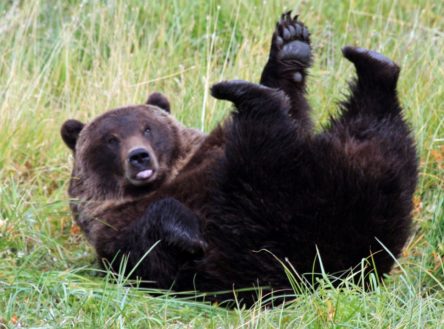TIPS: Be Safe When Bear Watching…

Life Saving Tips to Keep You Safe When Bear Watching.
We live on an old farmstead, complete with old apple, pear and cherry trees, as well as a blueberry field.
So we get hungry wildlife — from deer to seagulls (in blueberry season, the gulls love to decorate the field with blue poop).
And we’ve had a few bear encounters ourselves. A fierce, loyal german shepherd has proven to be an effective defence. Mostly, our Atlantic Coast bears just run off.
Here in Nova Scotia, there have been more attacks from coyotes than genus ursus (never jog in a wilderness area — if you’re running from them, that age-old prey drive kicks in).
And a LOT more deaths in the City by humans fighting each other for Drug Turf.
Attacks by West Coast black bears and grizzlies are a bit more common.
In Alaska, 40-year-old oil company employee and filmmaker from Anchorage, Charles Baird, is moving to the mostly uninhabited Latouche Island in Alaska’s Prince William Sound, completing a dream he’s been contemplating for seventeen years.
Baird is well aware of the problems faced by a modern day settler. Such as black bears. There’s a large bear population on the island, and one local resident explains they “love to get into trouble.”
Baird said he’ll be safe from the bears. He’ll carry a .44 with him at all times, has a shotgun “and a few other weapons, as well.” The dog will also alert him to any predators.
 “Do you like animals? If so, then Alaska is the place to travel to,” says author Martha Lapinski.
“Do you like animals? If so, then Alaska is the place to travel to,” says author Martha Lapinski.
“In Alaska, you can find wildlife ranging from wolves to moose and from caribou to mountain goats. You can also find an array of fish, birds, amphibians and reptiles there.
“In Alaska, you can even watch animal species that are endangered, including the Short-Tailed Albatross, the Leatherback Turtle, the Steller’s Sea Lion, and the Blue Whale,
“But Alaska bear viewing may arguable be the most thrilling wildlife activity in Alaska.”
Although you will probably not find Winnie the Pooh or Yogi Bear (or Boo-Boo Bear) in Alaska, you can observe the following varieties of the larger-than-life mammals:
Brown Bear: The Brown Bear is a huge variety, whose color is generally, as you might have guessed — brown. However, the bear’s coat can also be tan or black. Some Brown Bears in Alaska can be as heavy as 1,000 lbs! (450 kg). These huge creatures tend to eat grasses and the roots of plants, although they may also consume ants; fish; and all sizes of mammals, ranging from moose to Black Bears.
Black Bear: This is another enormous mammal that you may spot during Alaska travel. The Black Bear’s coat typically is brown, though it can also be a lighter tan or a darker black. Female Black Bears’ weight usually ranges from 25-40 lbs. (110-200 kg), while the males’ weight typically is a heavier 350-850 lbs. (160-385 kg). The diet of these bears resembles the Brown Bears’, and also includes the same variety of plants and animals.
Grizzly Bear: The grizzly has a strong, heavy body with an average length of 1.8 metres from nose to tail, or 7 to 8 feet. It can weigh between 500 to 1200 pounds. It is distinguished from other bears by the large shoulder hump that supports its massive front legs, its extremely long front claws and the concave facial profile of its large head. The grizzly bear’s fur is usually darkish brown, but can vary from ivory yellow to black. It has long hairs on its head and shoulders that often have white tips and give the bear the “grizzled” appearance from which it derives its name. Its legs and feet tend to be even darker in colour.
Polar Bear: The color of this bear’s coat ranges from white to yellow. But in fact, the fur actually consists of clear, empty hairs. Female Polar Bears weigh roughly 450-600 lbs., while their male counterparts tend to be roughly 900-1,300 lbs (400-590 kg). Polar Bears are generally classified as carnivores, as they primarily eat fish and seals. They will also consume animals such as walruses and beluga whales. On the other hand, during summertime, Polar Bears feast on grasses, berries, and even the decaying flesh of dead animals.
You can observe any of these three varieties of bears, in several Alaskan locations:
Anan Creek: The Stan Price Bear Sanctuary is an excellent habitat for Brown Bears, as they eat the salmon swimming up the creek.
Denali National Park: The majority of the visitors to this park have the privilege of spotting bears.
Katmai National Park: Roughly 2,000 Alaskan grizzly bears call this area their home. In July and September, enjoy watching bears feast on salmon.
Kodiak National Wildlife Refuge: The Kodiak Brown Bear is classified as the world’s largest meat-eater. From June to September, you can watch as the Bears meet for a hunting party.
McNeil River Game Sanctuary: This is the state’s most famous area for viewing bears. Bears gather in this area once annually, not for a family reunion, but to catch fish at McNeil River Falls. The best time to observe bears is from the middle of June, to the last part of August.
Here are some tips to keep you safe when bear-watching in Alaska:
1. Stay at least 50 yards from a bear, and 100 years if its cubs are around.
2. Keep your camp clean at all times.
3. Be aware of everything around you.
4. Never bother a bear hunting for food
5. If you meet a bear, speak confidently, but calmly.
6. Never get in a bear’s path.
7. Never surprise a bear.
8. Keep your food stored 10 feet above the ground.
9. Retreat from a bear gradually and silently.
10. Never run from a bear. Stand completely still if it approaches you.
11. If a bear touches you, play dead.
Bear watching can be one of the biggest thrills when you enjoy Alaska travel deals. But before you leave your home, familiarize yourself with the locations and types of the furry creatures, as well as ways to keep yourself safe. It will make your trip much more bearable!
Alaska is among North America’s to summer vacation spots and for good reason. Get more information regarding Alaska travel.
“Live Free, Mon Ami!” – Brian Alan Burhoe












